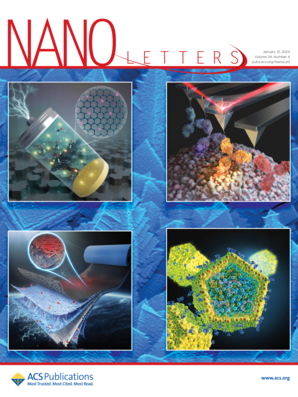Limited Electron-Dominated Electrorheological Response with TiO2 Buffer Layer
IF 9.6
1区 材料科学
Q1 CHEMISTRY, MULTIDISCIPLINARY
引用次数: 0
Abstract
We report porous carbon sphere electrorheological (ER) nanoparticles coated with a titanium dioxide layer (HCs@TiO2). Utilizing the buffering effect of amorphous TiO2, the HCs@TiO2 ER fluid (ERF) shows a yield stress that exceeds that of previous carbon-based ER nanomaterials. The mechanisms of the high ER response are elucidated through the analysis of the dielectric properties, demonstrating that the amorphous TiO2 shell not only restricts the electron-dominated motion but also significantly improves the interfacial polarization. Furthermore, the HCs@TiO2 ERF exhibits superior sedimentation stability and low current density, which is attributed to the formation of a hydrogen bond network. The rheological behavior of HCs@TiO2 ERF is analyzed using the Bingham and Cho–Choi–Jhon model, where the dynamic yield stress as a function of electric field strength is fitted using a generalized yield stress equation. These analyses indicate that local electrostatic accumulation between the hybrid shells benefits the ER response.

求助全文
约1分钟内获得全文
求助全文
来源期刊

Nano Letters
工程技术-材料科学:综合
CiteScore
16.80
自引率
2.80%
发文量
1182
审稿时长
1.4 months
期刊介绍:
Nano Letters serves as a dynamic platform for promptly disseminating original results in fundamental, applied, and emerging research across all facets of nanoscience and nanotechnology. A pivotal criterion for inclusion within Nano Letters is the convergence of at least two different areas or disciplines, ensuring a rich interdisciplinary scope. The journal is dedicated to fostering exploration in diverse areas, including:
- Experimental and theoretical findings on physical, chemical, and biological phenomena at the nanoscale
- Synthesis, characterization, and processing of organic, inorganic, polymer, and hybrid nanomaterials through physical, chemical, and biological methodologies
- Modeling and simulation of synthetic, assembly, and interaction processes
- Realization of integrated nanostructures and nano-engineered devices exhibiting advanced performance
- Applications of nanoscale materials in living and environmental systems
Nano Letters is committed to advancing and showcasing groundbreaking research that intersects various domains, fostering innovation and collaboration in the ever-evolving field of nanoscience and nanotechnology.
 求助内容:
求助内容: 应助结果提醒方式:
应助结果提醒方式:


